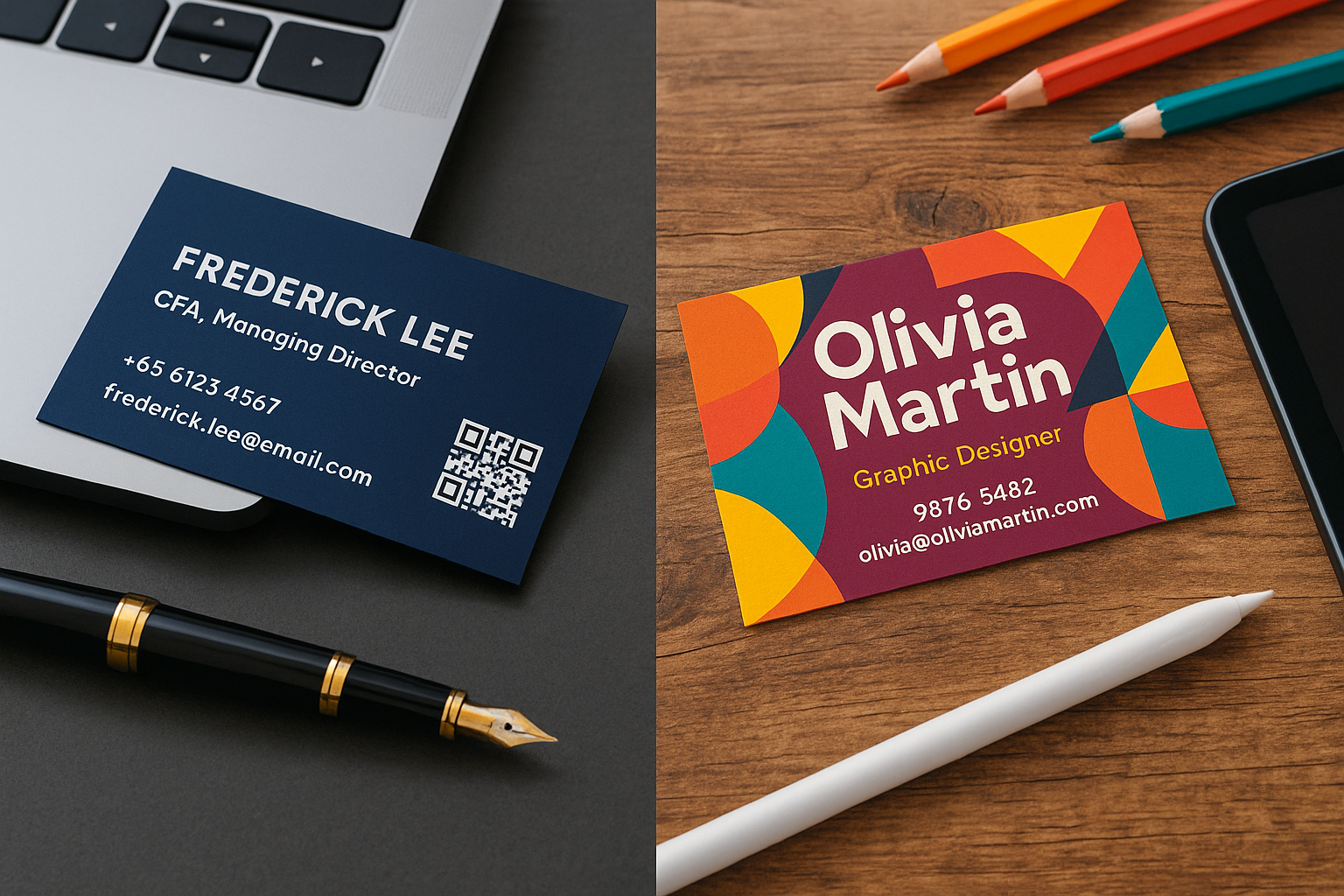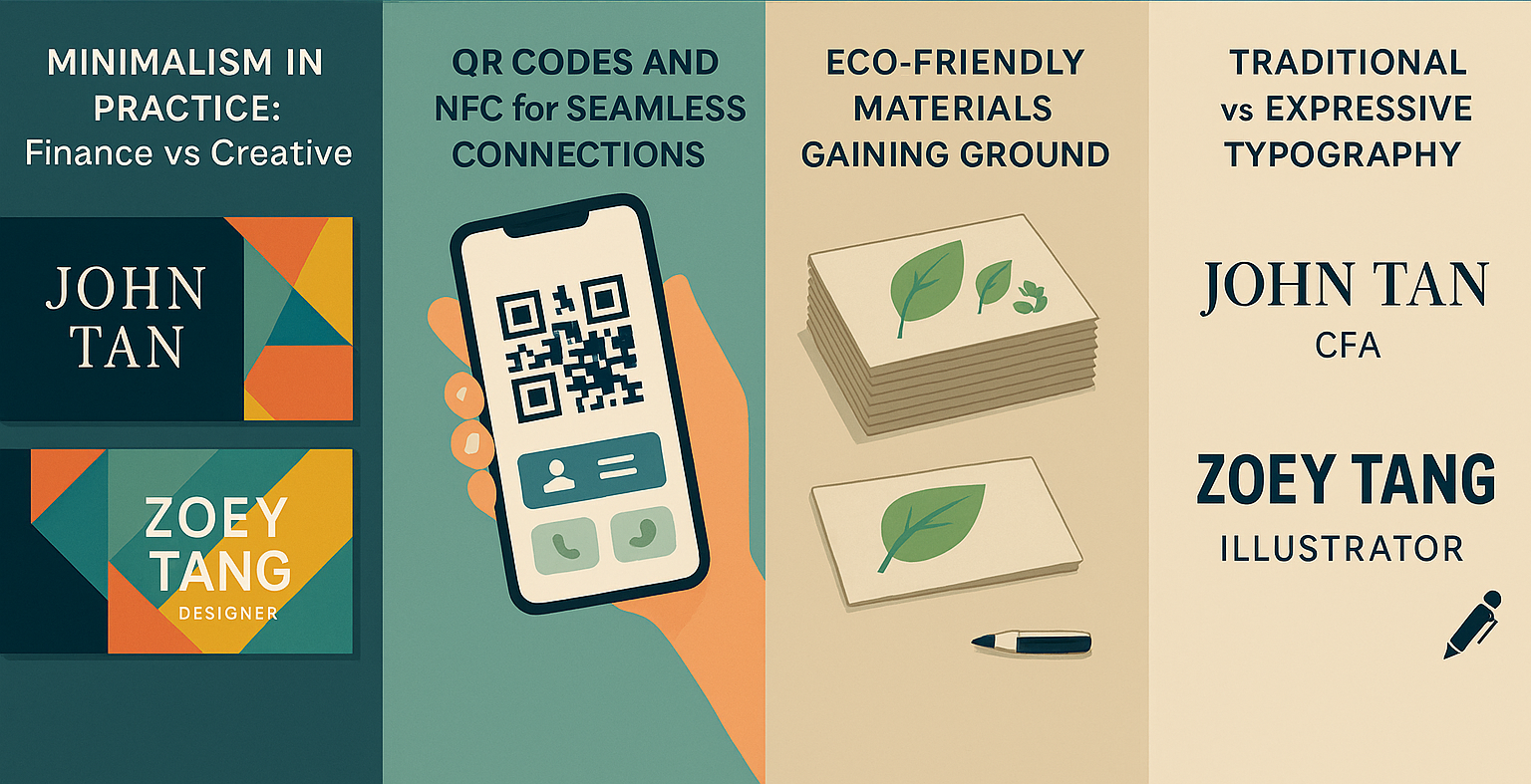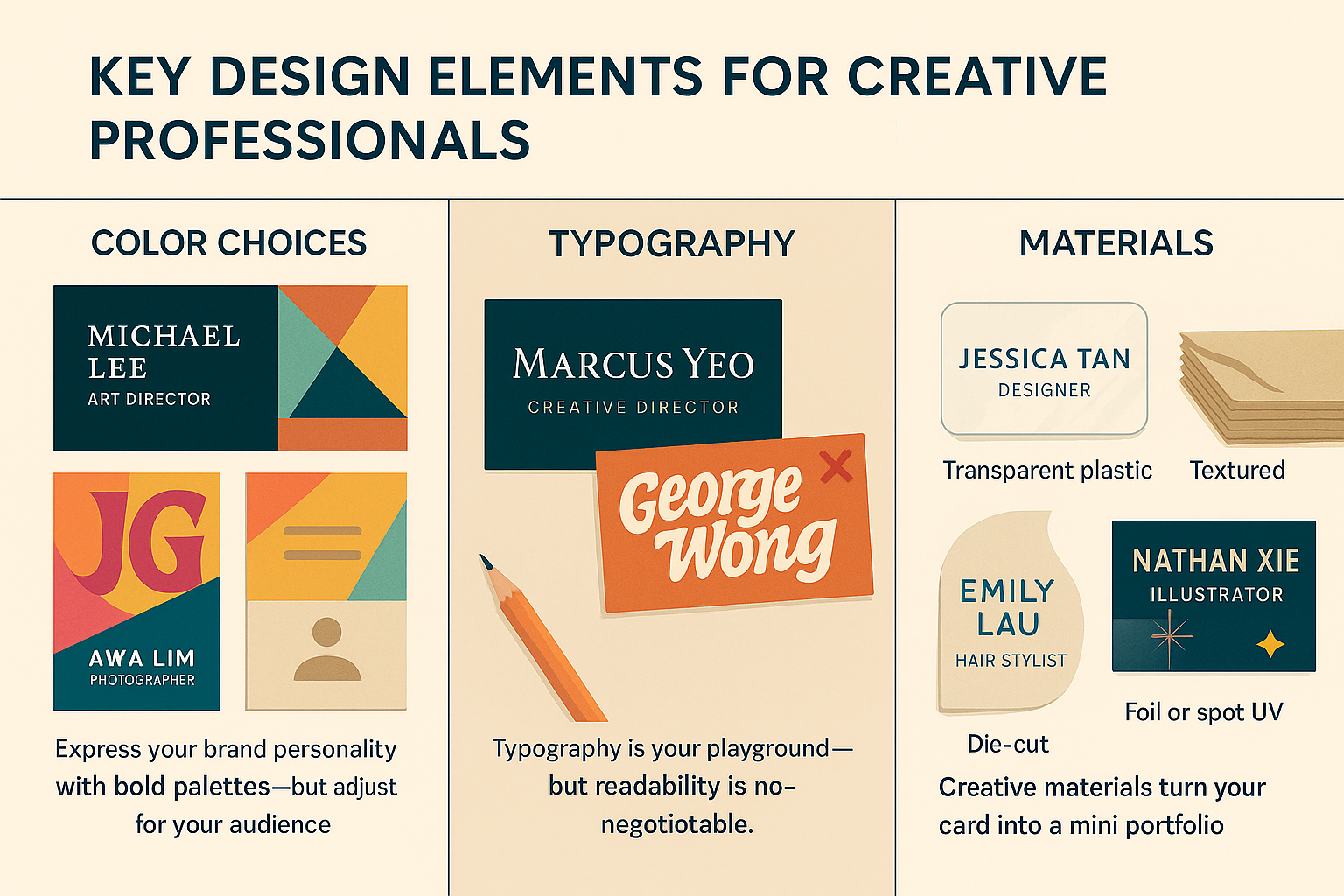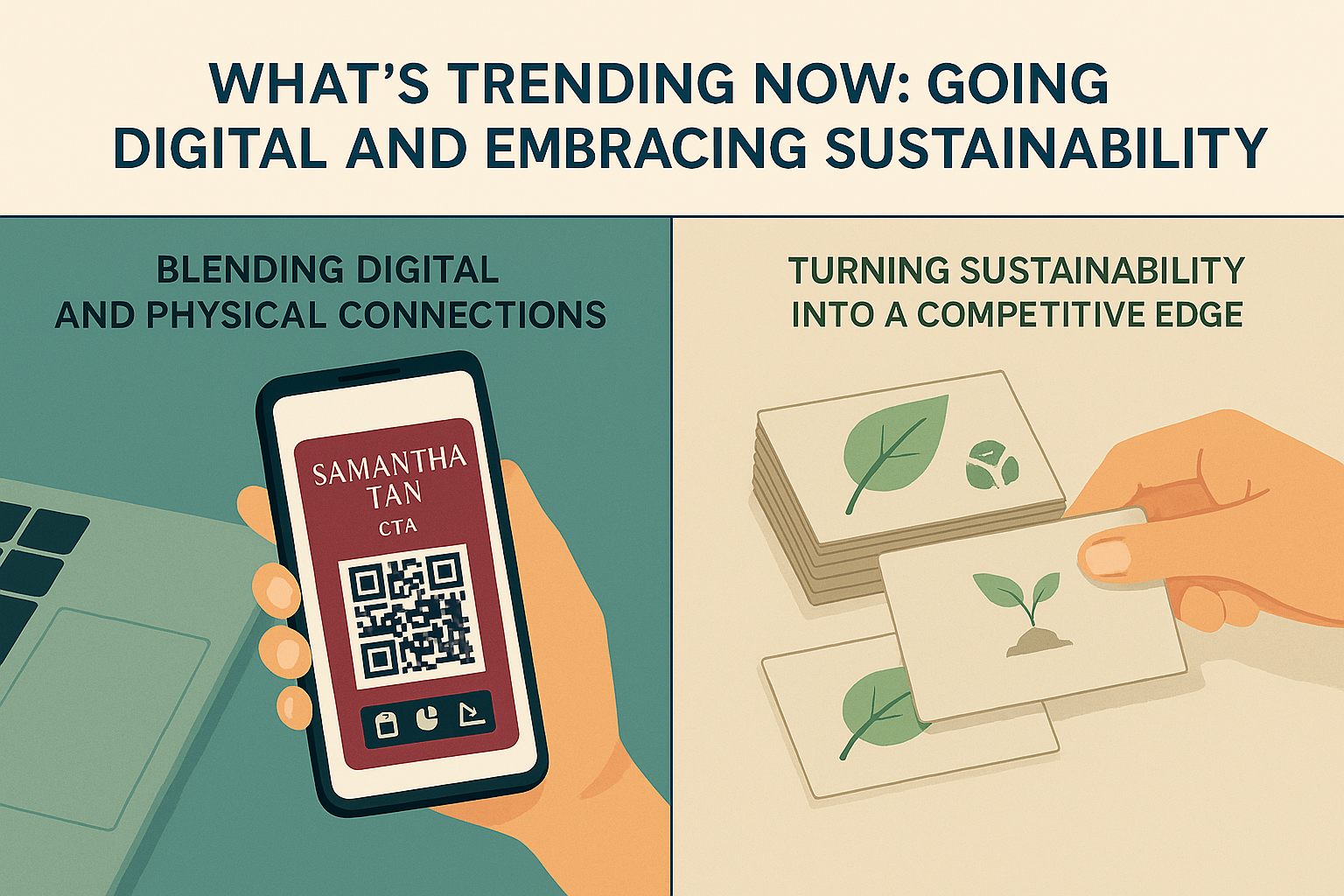
Business Card Designs in Singapore: Finance vs Creative — Your Complete Strategy Guide
June 11, 2025
Singapore’s competitive business landscape calls for more than just a firm handshake—your business card still plays a key role in how you’re remembered. When it comes to industry-specific business card designs in Singapore, professionals in finance vs creative sectors face very different expectations. In 2024, Singapore’s finance sector surged by 6.8%, setting records in assets under management. Meanwhile, creative industries continue to thrive, cementing their role as a vital engine of economic growth.
Singapore is unique in how it blends financial credibility with creative innovation. But that also means your business card must reflect the culture, tone, and expectations of the field you’re in. A polished, minimal design might signal trust in finance, but it could feel too bland for someone in branding or digital media.
There’s more on the line now than ever before. Research shows that 72% of people judge a company's professionalism based on business card quality alone, while39% won't do business with someone carrying a "cheap-looking" card. In Singapore’s multicultural business scene, where networking events are a daily affair and connections are the backbone of success, your business card isn’t just a formality; it’s a powerful tool that can open doors and push your career or business forward.
Why Industry-Specific Design Is More Important Than Ever in Singapore
Singapore’s business culture is a unique blend of East and West. On one hand, there’s the Western emphasis on efficiency and professionalism. On the other, there’s the Asian focus on relationships and first impressions. That’s why your business card design isn’t just about aesthetics, it’s a strategic move that signals who you are and what you represent.
For finance professionals in areas like the Central Business District, a conservative, polished card helps reinforce trust and credibility. In contrast, creative agencies based in Kampong Glam or Clarke Quay lean on bold, personality-driven designs that reflect innovation and originality.
Recent numbers reflect how distinct these sectors really are. In 2024 alone, Singapore’s fintech industry attracted US$1.3 billion in investment. At the same time, creative industries powered by design, media, and content creation are playing a bigger role in GDP, thanks to Singapore’s strong digital infrastructure and regional influence.
The takeaway? Both sectors are growing fast, but they speak entirely different visual languages. If your card doesn’t match your industry’s tone and expectations, you risk missing out on opportunities—especially in Singapore, where networking is a constant and every detail matters.

How Business Card Design Trends Are Redefining Singapore’s Professional Scene
Singapore’s business card trends are evolving fast. Here’s what’s shaping them in 2025:
- Minimalism stays king, but execution varies:
- Finance pros prefer clean, conservative layouts that signal trust.
- Creatives use minimalism as a canvas for bold colour, typography, or layout experiments.
- A clean layout helps key details stand out—essential in Singapore’s fast-paced networking culture.
- Digital features are now expected:
- Adding a QR code can boost engagement by up to 20%.
- Singapore’s digital infrastructure (e.g. SG-Verify) has made scanning second nature.
- Finance: QR codes link to appointment booking or market updates.
- Creative: QR codes often link to portfolios, past projects, or social channels.
- Sustainability is now a design driver:
- Some firms have cut carbon emissions by up to 86% by switching to digital or recycled cards.
- Singapore’s green agenda is influencing younger professionals in both industries.
- Eco-conscious choices like recycled paper or plantable seed cards are gaining traction.
- Typography is getting more expressive:
- In creative industries, bold, custom fonts and experimental layouts showcase personality and design chops.
- Finance cards still favour readability and subtle elegance, using refined serif or crisp sans-serif fonts with a modern twist.
Business cards are no longer just paper—they’re touchpoints that connect physical networking with digital presence and sustainable branding.
Finance Industry Business Cards: Earning Trust with Classic, Professional Design
In Singapore’s financial world, your business card needs to do one thing immediately: signal trust. The finance industry’s conservative style exists for a reason—it’s about handling high-stakes client assets, from personal wealth to corporate treasuries.
Singapore’s banking sector now manages over S$5.4 trillion in assets, reinforcing the importance of credibility in every touchpoint—including business cards.
What Makes a Great Business Card for Finance Professionals
1. Colours
The colours you choose subtly shape how people perceive your professionalism and trustworthiness.
- Stick with blue as your anchor—it signals stability, trust, and professionalism.
- Common palettes: deep navy, rich charcoal, andcrisp white for a timeless, high-trust look.
2. Typography
Prioritise readability and tradition.
- Use classic fonts like Times New Roman (serif for authority) or Helvetica (clean sans-serif).
- Emphasise names and credentials (CFA, CFP, CLU) using font hierarchy—larger size or bold weights.
3. Material Quality
- Don’t cut corners—premium cardstock (350 gsm or higher) is the baseline.
- Finishing options that add polish: matte lamination, embossing, or letterpress for tactile quality.
4. Information Hierarchy
Follow a clear flow.
- Name (highlighted or bolded)
- Credentials
- Company name
- Contact info (phone, email, website)
- Regulatory licence (for insurance agents or financial advisors)
In finance, trust is built on precision and clients notice the details. Whether consciously or not, people assess a professional’s credibility by how polished their business card looks. Flawless alignment, consistent spacing, and zero typos reflect the kind of meticulous attention to detail that clients want in someone managing their money. A well-designed card can even improve sales performance by up to 2.5%—a small but meaningful edge in a relationship-driven industry.
In Singapore, the way you exchange a business card matters just as much as the design itself. It’s common practice to offer your card with both hands, receive the other person’s with respect, take a moment to read it, and place it neatly on the table. This subtle ritual reflects professionalism and courtesy, turning a simple introduction into the first step toward a trusted business relationship.
Creative Business Cards: Pushing Boundaries Without Losing Focus
In Singapore’s creative scene, a business card is more than contact info—it’s a mini portfolio. With fierce competition across design, media, and digital sectors, creative professionals must balance artistic expression with business credibility. It’s not enough to be bold—you also need to be strategic.
Creative Freedom, With Intention
Unlike finance, the creative industry allows for far more experimentation. But design freedom still comes with limitations: your card must remain clear, legible, and usable. Whether you’re pitching to corporate clients or lifestyle startups, your design has to flex to meet different audience expectations.

Key Design Elements for Creative Professionals
1. Colour Choices
- Go bold but smart. Creative cards often feature unexpected palettes, pops of vibrant accents, or surprising pairings to express personality.
- That said, creative agencies working with conservative clients (e.g. finance or legal) may lean toward more restrained tones.
2. Typography
- Typography is your playground. Use daring fonts, hand-drawn letters, and layouts that break the grid.
- Still, readability is non-negotiable. Even the boldest type choices must stay clear at first glance.
3. Materials
- Materials make a strong impression. Standouts include transparent plastics, textured or recycled paper, die-cut or irregularly shaped cards, spot UV, foil, or layered finishes.
- These design touches communicate high craftsmanship—something clients remember.
Balancing Creativity and Credibility
A great creative business card does two things at once: it showcases your design sensibility and signals that you’re a capable, results-driven professional.
- Maintain a clear information hierarchy.
- Ensure branding is consistent across platforms.
- Include professional contact details and URLs—not personal tags.
Adding a QR code can take your card from simple to smart. Instead of cramming portfolio samples onto a small card, link it to a curated portfolio or a recent campaign showcase. It turns your card into a launchpad for deeper engagement.
A Practical, Step-by-Step Guide to Picking the Right Business Card Design for Your Industry
Step 1: Get clear about your role and who you’re trying to reach.
Start by taking a clear, honest look at where you stand in Singapore’s business landscape.
- Finance professionals should consider their specific sector: wealth management, corporate banking, insurance, or fintech, as each carries different design expectations.
- Creative professionals need to take a hard look at who their main clients are and what services they offer before deciding just how far they can push their creativity.
- Take the time to note where and how you usually network. What works in a corporate boardroom won’t fly in a creative co-working space or at a bustling industry conference, for that matter.
Step 2: Decide what information goes where and how you’ll present it.
No matter what industry you’re in, the basics stay the same: your full name, job title, company name, phone number, email, and website all need to be there.
- Finance pros usually tack their credentials right after their names, but folks in creative fields tend to highlight unique skills or specific creative roles instead.
- What you choose to add depends largely on your industry. A financial advisor may want to list their regulatory licences or areas of expertise, while someone in a creative field might include a link to their portfolio or a site where they showcase collaborations.
- QR codes serve different purposes. Finance professionals typically link to appointment scheduling, while creatives showcase portfolios.
Step 3: Choose the right visuals for your card
Choosing the right colours takes more than just picking your favourites—it calls for some real strategic thought.
- If you work in finance, you’ll want to stick with blues, greys, and whites—these colours instantly signal trust and stability.
- Creative professionals have the freedom to play with a wider range of colours, choosing palettes that reflect their brand’s personality and appeal to the tastes of their target audience.
- When it comes to typography, you need to think carefully about two things: how easy it is to read and whether it truly matches your brand’s personality.
Step 4: Pick your materials and decide how you’ll have your cards made
The paper you choose sends an instant message about the level of quality people can expect.
- If you work in finance, don’t skimp on quality—choose a sturdy cardstock of at least 350 gsm and opt for premium finishes that instantly convey professionalism.
- Creative professionals have the freedom to experiment with unconventional materials. Consider textured paper or eco-friendly options that reflect their brand’s values.
- Finishing touches are where you can really set your business card apart—without straying from what’s expected.
Step 5: Launch and monitor performance
Distributing your card is just the beginning—pay attention to how it performs and refine your approach.
Design Mistakes Everyone Makes and How to Steer Clear of Them
In Singapore’s competitive business environment, even small missteps in business card design can cost you credibility and opportunities. Here’s what to watch out for (and how to fix them):
Trying to cram in too much?
One of the most common mistakes is trying to say everything on one tiny card.
- Finance professionals often overdo it with credentials and contact details; creatives cram in multiple roles or skills.
- The result? Cluttered cards where nothing stands out.
What to do instead: Prioritise key info and let white space work for you. Use a QR code to link to more details.
When Typography Hurts Readability
- In finance, using dated or overly formal fonts can feel stiff or out-of-touch.
- In creative industries, wild or trendy fonts sometimes sacrifice legibility.
- What to do instead: Choose fonts that reflect your brand and are easy to read in all contexts.
What to do instead: Choose fonts that reflect your brand and are easy to read in all contexts (photos, low light, photocopies). Test your layout with people across age groups or backgrounds to make sure it holds up.
Overlooking Cultural Differences
- Singapore’s diversity makes design tricky—colours and symbols can carry different meanings across cultures.
- What looks bold in one culture could seem inappropriate or unlucky in another.
What to do instead: Do your homework on colour symbolism and visual cues. When in doubt, stick to clean, universally professional palettes. If you’re targeting a specific audience, test your design with them directly.
Outdated or Incorrect Information
- Nothing undermines credibility faster than wrong contact details or job titles, especially in finance.
- Small mistakes suggest carelessness, which can hurt trust before you even speak.
What to do instead: Review and update your business card regularly. If you switch roles often or work across multiple projects, consider digital formats that let you update your info instantly without reprinting.

What’s Trending Now: Going Digital and Embracing Sustainability
Singapore’s business card scene is quickly changing, with new tech innovations and a growing focus on sustainability transforming how professionals connect and network.
Blending Digital and Physical Connections
Rather than replacing business cards entirely, many professionals in Singapore are combining physical design with smart digital features. A well-placed QR code can turn a quick handshake into a lasting connection, whether it links to a booking page, a market update, or a design portfolio.
Some are also adopting NFC-enabled cards, which allow recipients to tap their phone and access contact info or custom landing pages instantly. Early adopters report great results, especially with younger, tech-forward clients who appreciate the seamless interaction.
Turning Sustainability into a Competitive Edge
Sustainability is becoming a key consideration across industries. Switching from traditional cards to digital alternatives can reduce carbon emissions by up to 86%, making it an easy win for professionals and businesses aiming to go greener.
In Singapore, where environmental goals are increasingly prioritised, eco-friendly business card materials are gaining traction. Options range from recycled cardstock and biodegradable plastic to seed paper that can literally grow after use. Creative professionals tend to lead the charge here, using sustainable materials to reflect their values and stand out. Finance professionals are also getting on board, though usually with more cautious choices that don’t compromise quality or presentation.
Ultimately, the best business cards in Singapore strike a balance between professionalism, personality, and progressiveness. They meet industry standards, stand out visually, and embrace forward-thinking trends without sacrificing clarity or credibility.
Questions People Ask All the Time
How do I pick the right paper weight for business cards in Singapore’s finance and creative industries?
If you’re in finance, don’t skimp on cardstock. Start with at least 350 gsm. That extra heft instantly signals the kind of quality and stability your clients count on from a financial professional. Choosing a premium 400 gsm cardstock gives your business card a satisfying heft—one that instantly signals you’re serious about your work and willing to invest in quality. Creative professionals get a lot more leeway. Often, a standard 300 gsm card does the trick, especially when it’s dressed up with unique textures or eye-catching finishes that show off their design chops. The trick is to pick something that meets your industry’s standards for quality, but still makes sense for your budget.
How can I add a QR code to my business card without making it look tacky or unprofessional?
If you’re adding a QR code, make sure you place it thoughtfully and give people a good reason to scan it. Finance professionals are better off placing QR codes discreetly—like on the back of the card—and linking them to things like appointment booking or market updates, not personal social media. Add a short note such as “Scan for market updates” or “Schedule a consultation” so people know exactly what to expect. Creative professionals have more freedom to make their QR codes stand out, often weaving them right into the design, just as long as those codes link to polished portfolios, not personal pages.
Is it a good idea to put my social media handles on a business card in Singapore?
Whether or not to include social media on your business card really comes down to two things: is the platform actually relevant to your work, and does it offer any real value? Most finance professionals steer clear of putting social media handles on their business cards unless they’re actively sharing useful, client-focused content on LinkedIn to build their reputation as thought leaders. Creative professionals can make a strong impression by sharing their Instagram or Behance profiles to highlight their work, but it’s best to leave personal Facebook or Twitter accounts off the card. Make sure anything you post on social media meets professional standards—chances are, anyone who gets your business card will check out your profiles.
How do cultural differences shape the way business cards are designed in Singapore?
Singapore’s multicultural business scene calls for a thoughtful approach to different cultural tastes—but there’s no need to overcomplicate your design in the process. Classic colour palettes like blues, greys, and whites tend to work well no matter who you’re dealing with. Red, on the other hand, is seen as lucky and positive in Chinese settings, but it can come across as intense or even off-putting in other cultures. Put professionalism front and centre, and only weave in cultural symbols if you’re aiming for a specific community. The business card exchange protocol—where you present your card with both hands and receive respectfully—matters more than design elements for cross-cultural success.
Your Next Steps: A Practical Checklist for Designing Your Business Card
Want to make your networking efforts really count? Here’s a practical, step-by-step guide built for Singapore’s fast-paced, relationship-driven business scene.
- Assess Your Position and Goals
Start with a clear, honest look at your professional role and what you want to achieve through networking.
- Finance professionals should note their client base, relevant regulatory requirements, and how they stand out from competitors.
- Creatives need clarity on their target audience and how bold they can go with design without confusing potential clients.
Define your success metrics: Are you aiming to generate leads, grow brand awareness, or build authority? Let those goals shape your design strategy.
- Plan Your Information Architecture
Make sure essential contact details are front and centre: name, title, company, phone, and email. Only include extras, like QR codes or portfolio links, if they serve a clear purpose.
Avoid the temptation to overload your card. Instead, use digital elements like QR codes to link to extended info, but make sure the card still functions on its own even without a scan.
- Nail the Design and Execution
Design your card to match industry expectations while reflecting your unique style.
- Choose fonts that are both readable and aligned with your brand.
- Test your design in different lighting conditions and with people across age groups to ensure legibility.
- Get feedback from peers or clients before going to print—you might spot things you missed.
- Handle Production Like a Pro
The material and finish of your card say a lot about you— don’t treat printing as an afterthought.
- Request print samples first to check for colour accuracy, alignment, and finish.
- Choose materials that support your brand: sturdy and refined for finance, or textured and experimental for creatives.
- Estimate quantities realistically. It’s better to reprint with updated details later than to waste money on outdated stock.
- Launch and Monitor Performance
Distributing your card is just the beginning—pay attention to how it performs.
- Note which events, introductions, or follow-up tactics generate actual responses.
- Capture feedback or recurring comments. What catches attention? What’s forgotten?
- Use those insights to refine your next batch of cards and improve your overall networking strategy.
Final Thoughts
In Singapore’s dynamic business landscape, your business card is often the first impression people get of your professional brand. Whether you’re building trust in finance or expressing bold creativity, a well-designed card can make all the difference.
The best cards strike a clear balance: they reflect industry standards, show your unique value, and embrace evolving trends—from digital integration to sustainability. When done right, your card becomes more than a piece of paper. It’s a conversation starter, a credibility marker, and a quiet reminder of what you stand for.
At Inkcredible Solutions, we specialise in helping professionals and businesses across industries design business cards that don’t just look great, but also perform. Whether you're refreshing your personal brand or launching a company-wide update, we’ll work with you to create cards that match your goals, market, and personality.
Ready to stand out in Singapore’s competitive business scene? Let’s create a card that gets you remembered for all the right reasons.
Need Industry-Specific Business Cards?
Contact our team at Inkcredible Solutions for expert guidance on creating business cards that leave a lasting impression.
Get in Touch